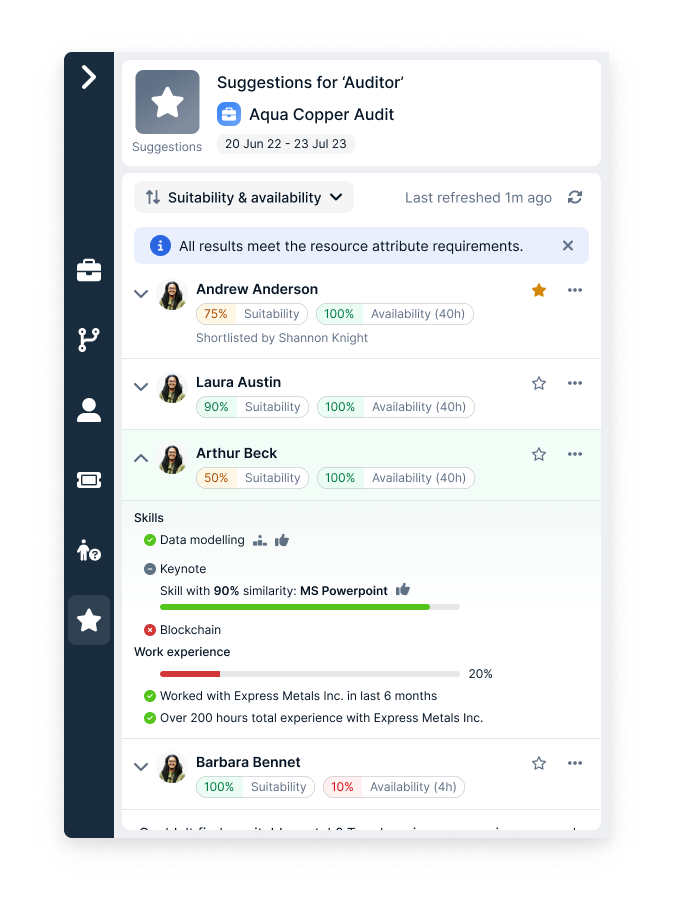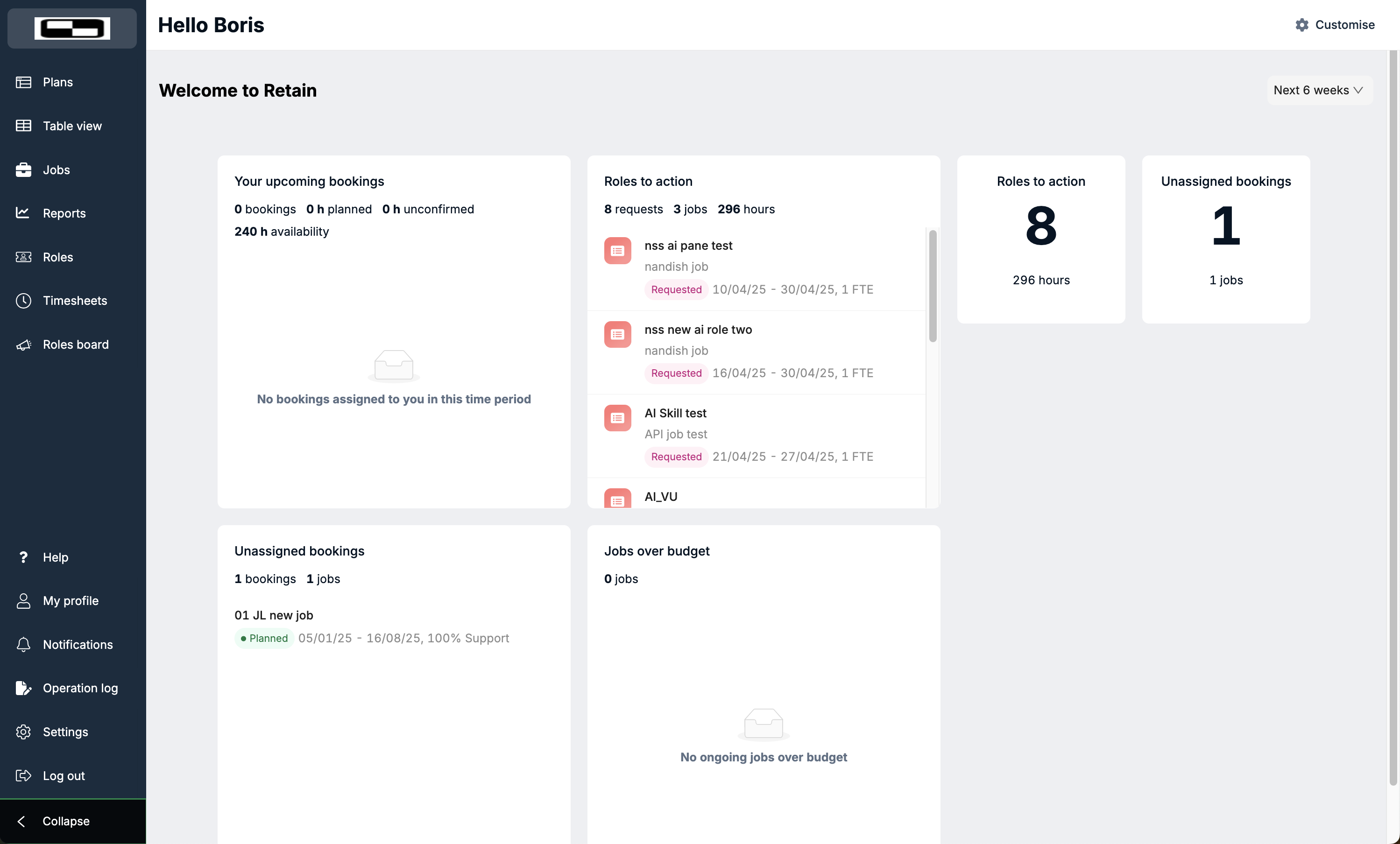Engineering firms know the challenge well: hitting high utilisation rates is harder here than in almost any other discipline. In fact, just 4.5% of engineering firms achieve 90%+ utilisation, compared with 16.8% across the wider consulting market.
As well as global talent shortages, the issue is also due to how resources are allocated. Too often, project staffing decisions start and end with availability. Who’s free next week? Who can we move over from another project? The result is that highly skilled engineers are left on the bench, mismatched expertise slows delivery, and a handful of “go-to” people carry an unsustainable load.
In our engineering resource planning software buyer’s guide, we covered the features firms should look for in a platform. This article takes the conversation further, looking at why skills, experience, and even preferences should sit alongside availability in every allocation decision, and how that shift can close the utilisation gap while improving project outcomes.
The limits of availability-only planning for engineering

When deadlines loom, it’s tempting to fill roles with whoever’s free. On paper, the schedule gets covered. But in reality, the cracks appear quickly.
Availability-only planning assumes that any engineer can be swapped in without affecting delivery quality. But in engineering, where technical depth, sector knowledge, and compliance requirements matter as much as capacity, that assumption rarely holds.
The risks are clear:
● Mismatched expertise → Rework, costly delays, and frustrated clients.
● Hidden bench strength → Talented engineers sit idle simply because their skills aren’t surfaced in the planning process.
● Over-reliance on a few names → The same “safe pair of hands” gets booked again and again, leading to burnout and knowledge bottlenecks.
Over time, this approach erodes profitability and morale. It also drives utilisation rates down.
The engineering firms that outperform are those that look beyond capacity to understand exactly what each engineer brings to the table and use that insight to make smarter allocation decisions from the outset.
What skills-based engineering resource planning looks like

Skills-based planning starts with a simple shift in perspective: instead of asking “Who’s free?”, you ask “Who’s the best fit?”
That fit is built on three elements:
#1. Capabilities: The technical disciplines, certifications, and tool proficiencies needed to deliver the work to standard.
#2. Relevant experience: Project history in similar sectors, scopes, or regulatory environments.
#3. Workstyle and preferences: How an engineer works best, and what types of projects keep them engaged.
For engineering firms, this means going beyond a basic resource schedule and building a centralised, searchable skills profile for every team member. A strong skills database:
- Surfaces niche expertise that might otherwise be overlooked.
- Tracks how recently a capability was used, so you’re not assigning someone to a task they haven’t done in years.
- Links directly to past projects, making it easy to match proven experience to new work.
- Flags compliance requirements, so only qualified staff are assigned to regulated tasks.
When skills data is visible and trusted, allocation decisions become more precise. It’s the difference between simply filling a slot and strategically assembling the right mix of expertise from the start.
Balancing skills, experience, and preferences

In engineering projects, capability often comes down to a combination of the right skills, the right depth of experience, and the right working fit.
↪ Skills tell you whether someone can technically do the job.
↪ Experience shows whether they’ve done it before, in a similar environment, and to the standard the client expects.
↪ Preferences are often the most undervalued factor, but influence how motivated and engaged they’ll be while doing it.
Consider two engineers with identical skill sets. One has recent experience delivering large-scale infrastructure projects in the public sector. The other’s background is in small, private-sector builds. Both could technically do the job, but one will manage the specific requirements, stakeholders, and compliance processes more smoothly.
Preferences matter too. Some engineers thrive in high-intensity, short-deadline projects; others excel when they can focus on complex, long-term technical challenges. Aligning work with these preferences can improve productivity, reduce turnover risk, and lift morale, all of which feed back into higher utilisation and stronger project outcomes.
The best resource planning processes treat these three factors as inseparable. Availability may get someone on the project. Skills, experience, and preferences are what keep it on track. Just like in this example:

How smarter engineer matching improves utilisation

When allocation decisions factor in skills, experience, and preferences alongside availability, utilisation becomes a measure of effective deployment.
The gains show up in three ways:
#1. Reduced bench time
Skills visibility ensures capable engineers aren’t overlooked just because they aren’t top-of-mind. More people are matched to suitable work, faster.
#2. Fewer delivery issues
Matching proven expertise to project requirements cuts down on rework, delays, and costly troubleshooting. All of which eat into billable time.
#3. Higher engagement and retention
Engineers who work on projects that fit their strengths and interests are more motivated, more productive, and more likely to stay.
In practical terms, smarter engineer matching can help narrow the utilisation gap between engineering and other consulting industries. Instead of aiming for higher utilisation through sheer workload, firms can achieve it through better allocation logic, ensuring the right work goes to the right person at the right time.
Engineering technology for skills-first planning

Building allocation decisions around skills, experience, and preferences takes more than a spreadsheet. The volume of data and the need for it to be accurate in real time means engineering firms need tools that can keep pace with the complexity.
Modern engineering resource planning platforms bring three capabilities together:
Skills intelligence
A structured, standardised skills taxonomy makes every capability in the business searchable and comparable. It also links to project history, so you can see exactly where and when a skill was last applied.
AI-assisted matching
Automated suggestions that combine skills, availability, and team fit free up planners from sifting through lists. Importantly, the best tools provide transparent reasoning, so you can see why a match was recommended.
Real-time visibility
Live data on capacity, project demands, and booking status means allocation decisions are made with the most current information and no more chasing updates across multiple systems.
Integrations with core engineering systems, from engineering tools to finance and project management software, keep that data consistent across the organisation. The result is a single source of truth that supports both day-to-day scheduling and longer-term workforce planning.
For readers who want to explore platform capabilities in depth, our engineering resource planning software buyer’s guide breaks down the features to look for and the pitfalls to avoid.
Move from availability to capability
By factoring in capabilities, relevant experience, and preferences, engineering firms can close the utilisation gap, improve project delivery, and keep their best engineers engaged. The technology is here, the question is whether your planning process is ready to use it.
Ready to see how skills-first planning could work for your firm? Book a demo to see how smarter allocation can help you lift utilisation and deliver better projects.


